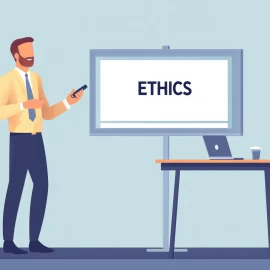

This article is an excerpt from the Shortform book guide to "Traction" by Gino Wickman. Shortform has the world's best summaries and analyses of books you should be reading.
Like this article? Sign up for a free trial here .
How do you identify workplace issues? What can you do to root them out before they escalate and compromise your key business functions?
Many leadership teams talk endlessly about problems without solving them. But unresolved workplace issues or problems drain your company’s energy.
Here is how to identify and resolve your workplace issues using the Entrepreneurial Operating System.
Resolving Workplace Issues
The Entrepreneurial Operating System provides tools to help your leadership team uncover the pertinent workplace issues, drill down to the cause, discuss solutions, and take action. The tools for tackling issues are an issues list and an “Issues Solving Track” (a three-step process).
The Workplace Issues List
The issues list is a tool for getting issues on the table and in one place where they can be dealt with. Organizations should keep three types of issues lists:
1) A quarterly meeting issues list: This is where you list non-urgent company issues that can be addressed in future quarterly leadership meetings. They’re not immediate priorities for this week or this quarter, but you need to note them so they won’t be forgotten. Examples include: new product ideas, HR issues, and capital needs.
2) A weekly meeting issues list: These issues are tackled at weekly leadership meetings.
They’re strategic, non-departmental workplace issues that need to be addressed this week or this quarter at the leadership level. Examples are: priorities being off track, a missed Scorecard goal, client issues, and process-related issues.
3) A departmental issues list: This list contains immediate departmental issues that must be handled at a weekly departmental meeting. For instance, sales department issues might include: not hitting call numbers, planning sales presentations, and closing sales. Operations department issues might include: production numbers and customer complaints.
With an open, problem-solving culture and these three issue lists, issues will surface regularly.
Once you’ve identified and listed them, the tool for resolving them is the “Issues Solving Track.”
The ‘Issues Solving Track’ (IDS)
The “Issues Solving Track” has three simple steps (the acronym is IDS):
- Identify
- Discuss
- Solve
First, look at your list and pick the top three (most important) workplace issues to be solved. When you work through issues in order of priority, some issues will disappear because they were really symptoms of a key issue you addressed. Discuss each of your top three issues using the three-step process:
1) I: Identify
First, drill down to the real issue or source of trouble. Probing for the underlying issue can be uncomfortable because problems usually involve people. But it’s important to be honest for the good of the company.
This step may take longer than the other steps. You may spend most of your time identifying the problem, and need only a few minutes to discuss and solve it.
There are generally three kinds of workplace issues:
- A problem to be solved
- Information to be communicated to the team and agreed on
- An idea someone wants feedback on
The person raising an issue should indicate the response needed—for example, she might say, “I just want to make sure everyone understands and agrees with the new maintenance contract.” This speeds up the process.
2) D: Discuss
The discussion step is where everyone gets a chance to weigh in. Many teams flounder on this step because they didn’t identify the real issue first. They talk a lot without solving anything.
However, once the team has identified the issue, there may be little need for discussion because the solution is clear. In that case, don’t be afraid to suggest a solution. This will either save time or it will prompt valuable discussion as people jump in to make additional points before it’s too late.
Avoiding Tangents
Discussions often drag on too long because they keep going off on tangents. One way to deter tangents is for team members to call out “Tangent alert” when the discussion starts going off track. If a tangent raises a real issue, however, add it to the list and refocus on the topic at hand.
3) S: Solve
In this step you determine a solution or conclusion, with an action for someone to take. Add the action item to a to-do list, and when it’s carried out, you’re done with the issue.
You should decide issues in ways that move you closer to achieving your vision. Thus, you can’t start solving issues until you’ve established your vision or you won’t make the right decisions. It would be like driving a car without knowing where you’re going—you won’t have a rationale for deciding where to make turns.
Tips for Solving Issues
1) When team members disagree on a solution, the integrator should make a decision and the team should get behind it. When views are split, the majority is often wrong. Also, as author Jim Collins pointed out in a Fortune magazine article, the most important decisions usually aren’t unanimous.
2) Get first-hand information. When an issue involves multiple people, you need to hear from all of them. Get everyone together to talk about it at the same time.
3) Act in the company’s best interests, not out of self-interest or for political reasons. Keep your eye on the company’s goals when making decisions.
4) You have three options for handling every problem: put up with it, end it, or change it. Putting up with it should be a last resort—you want to end it instead.
5) Face your fears and act. The issue you’re most afraid of is the one you need to tackle first.
Solution Statement
At the conclusion of the three steps (Identify, Discuss, Solve), a team member needs to verbally summarize what’s been decided and the next steps. For example: “Nicole will meet with John and discuss the warehouse issue. She’ll offer him a transfer to another position, and if he doesn’t take it, we’ll terminate him.”
Addressing Personnel Issues
When two people don’t get along, have a third party facilitate a solutions meeting with them. At the meeting:
- Have each person share what he believes are the other’s three biggest strengths and weaknesses.
- Identify the issues and solve them.
- List the steps to be taken for implementing the solution.
- Meet again in a month to ensure the steps were taken.
If this process doesn’t resolve the problem, you may have to let one of the individuals go or move him to another position.

———End of Preview———
Like what you just read? Read the rest of the world's best book summary and analysis of Gino Wickman's "Traction" at Shortform .
Here's what you'll find in our full Traction summary :
- How a first-time entrepreneur can gain the traction needed to grow
- Why hard work and determination aren't enough for your business to succeed
- The 6 key principles of the Entrepreneurial Operating System






